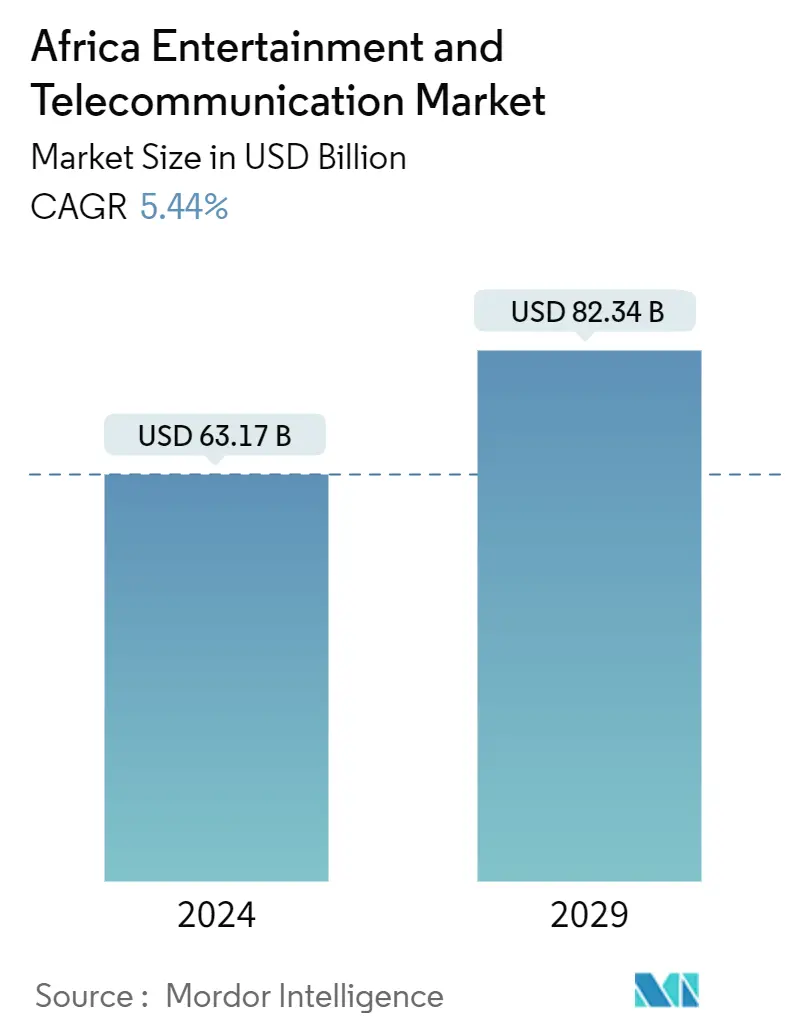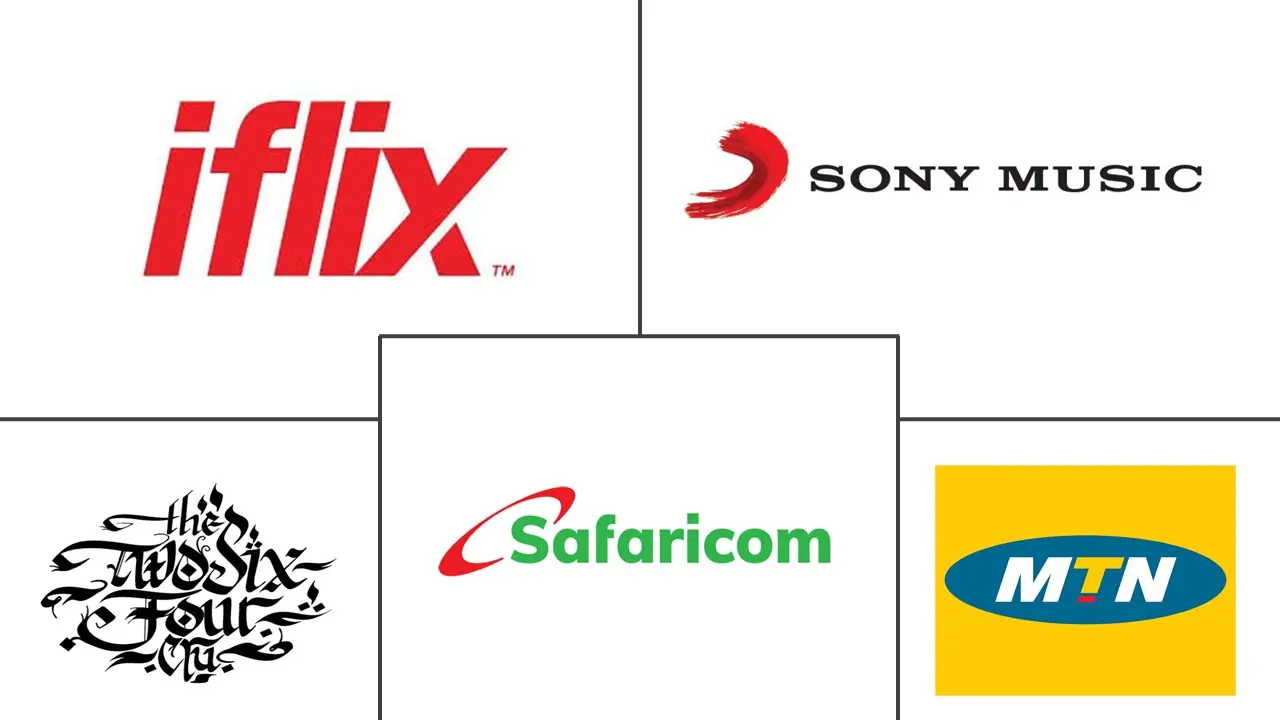Market Size of Africa Entertainment And Telecommunication Industry

| Study Period | 2019 - 2029 |
| Base Year For Estimation | 2023 |
| Market Size (2024) | USD 63.17 Billion |
| Market Size (2029) | USD 82.34 Billion |
| CAGR (2024 - 2029) | 5.44 % |
| Market Concentration | Medium |
Major Players
*Disclaimer: Major Players sorted in no particular order |
Africa Entertainment And Telecommunication Market Analysis
The Africa Entertainment And Telecommunication Market size is estimated at USD 63.17 billion in 2024, and is expected to reach USD 82.34 billion by 2029, growing at a CAGR of 5.44% during the forecast period (2024-2029).
With most African markets projected to grow online video revenues, the region's digital consumption growth is among the highest in the world. A large youth population, fast-improving mobile connectivity, and a flood of new streaming platforms into the market will drive this growth. As a result, the digital share of the video revenue will increase, resulting in the growth of the entertainment market in Africa.
- Africa has a young and rapidly growing population, which presents a unique market driver for the entertainment and telecommunication industry. With the increasing youth population, there is a growing demand for entertainment content and communication services. Additionally, rising disposable income levels among the middle-class population in Africa contribute to increased spending on entertainment and telecommunication services.
- According to the United Nations, Africa has the youngest population in the world, with over 60% of its population below the age of 25. This young demographic presents a significant market driver as the youth are avid consumers of entertainment content and early adopters of new telecommunication technologies. The demand for mobile data, streaming services, gaming, and social media platforms is on the rise, creating opportunities for the industry to cater to this growing consumer base.
- The African Development Bank reports that Africa's middle-class population is expanding, with a significant increase in disposable income levels. This rise in disposable income translates into increased spending on entertainment and telecommunication services. Consumers are willing to invest in high-quality content, mobile data plans, broadband connections, and value-added services, driving the growth of the entertainment and telecommunication market in Africa.
- The rapid expansion of mobile technology and digital transformation is another unique market driver in Africa. Mobile penetration rates are increasing, and the continent is witnessing a mobile-first approach, where smartphones and mobile devices are the primary means of accessing entertainment and communication services. The digital transformation of various industries, including media and telecommunications, is driving the demand for innovative content and connectivity solutions.
- Furthermore, in recent years, a shift in trend has been observed in the African region, wherein through the sale and leaseback agreements of mobile towers with tower companies, telcos are moving toward the asset-light or Mobile Virtual Network Operator (MNVO) model. In a nutshell, MVNOs are wireless communications services provider that does not own the wireless network infrastructure over which it provides services to their customers. Airtel and MTN are among the two major telco service providers leading the trend in the African region.
- In many parts of Africa, access to reliable and affordable internet connectivity remains a challenge. Infrastructure gaps, including limited broadband coverage and inadequate network infrastructure, hinder the expansion of Internet services. Additionally, high data costs and low-income levels in certain regions make internet access unaffordable for a significant portion of the population.
- According to the International Telecommunication Union (ITU), as of 2020, Africa's internet penetration rate stood at around 39.3%. While this indicates progress, it also highlights the digital divide within the continent, with significant variations in internet access between countries and urban-rural areas. Limited internet connectivity inhibits the adoption of entertainment and telecommunication services that heavily rely on internet access.
- In some regions, the lack of adequate telecommunications infrastructure, including reliable power supply and fiber-optic networks, poses challenges to expanding internet connectivity. Remote and underserved areas often face geographical barriers that make it difficult and costly to extend infrastructure and provide reliable internet services. These infrastructure challenges impede the availability and quality of internet connectivity required for entertainment and telecommunication services.
- COVID-19 restrictions, such as social distancing measures and the closure of cinemas and theaters, prompted a significant increase in the consumption of digital content and streaming services. People sought entertainment options at home, leading to a rise in the demand for movies, TV shows, music streaming, and other forms of digital entertainment.
- Various digital platforms experienced a surge in user engagement and adoption during the pandemic. For instance, local and international streaming platforms, such as Showmax, Netflix, and Disney+, reported increased viewership in Africa. These platforms catered to the growing demand for entertainment content, providing a wide range of movies, TV shows, documentaries, and original programming. There has also been an impact of the Russia-Ukraine war on the overall ecosystem.
Africa Entertainment And Telecommunication Industry Segmentation
As consumers become more digital, their media, entertainment consumption, and purchase habits have also evolved from multi-tasking while watching TV to accessing information via multiple devices. This brings challenges and opportunities around the distribution and consumption of both print and digital content for companies across this industry. The user experience and their engagement with the media industry are still the primary business objectives while investing in this sector.
The Africa entertainment and telecommunication market is segmented by telecommunication services type (voice (fixed and mobile), data (fixed and mobile)) and by country. The market sizes and forecasts are provided regarding value (USD) for all the above segments.
| By Platform | |
| PC | |
| Smartphone | |
| Tablets | |
| Gaming Console | |
| Downloaded/Box PC | |
| Browser PC |
| By Geography | |
| Nigeria | |
| Ethipia | |
| Egypt | |
| Morocco | |
| Kenya | |
| Algeria | |
| Zimbabwe |
Africa Entertainment And Telecommunication Market Size Summary
The Africa entertainment and telecommunication market is poised for significant growth, driven by a combination of factors including a youthful population, improving mobile connectivity, and the influx of new streaming platforms. The region's digital consumption is among the highest globally, with a burgeoning demand for mobile data, streaming services, and social media platforms. This demand is further fueled by rising disposable incomes within the expanding middle class, which is increasingly investing in high-quality content and advanced telecommunication services. The shift towards a mobile-first approach, where smartphones serve as the primary access point for entertainment and communication, is also a key driver of market expansion. Despite challenges such as infrastructure gaps and high data costs, the market is experiencing a transformation with the adoption of asset-light models like Mobile Virtual Network Operators (MVNOs), which are enhancing service delivery and customer reach.
The competitive landscape of the media and entertainment market in Africa is characterized by the presence of major players and the entry of new participants leveraging emerging technologies like 5G. The market is witnessing a strategic shift towards digital platforms, with significant investments from both local and international entities aimed at enhancing content distribution and accessibility. Subscription models are becoming increasingly popular, with players offering flexible pricing strategies to cater to price-sensitive consumers. However, regulatory challenges and additional taxes on internet usage pose potential hurdles to growth. Despite these challenges, the market continues to expand, supported by investments in infrastructure and partnerships aimed at enhancing connectivity and service quality across the continent.
Africa Entertainment And Telecommunication Market Size - Table of Contents
-
1. MARKET DYNAMICS
-
1.1 Market Overview
-
1.2 Industry Value Chain Analysis
-
1.3 Industry Attractiveness - Porter's Five Forces Analysis
-
1.3.1 Bargaining Power of Suppliers
-
1.3.2 Bargaining Power of Consumers
-
1.3.3 Threat of New Entrants
-
1.3.4 Threat of Substitutes
-
1.3.5 Intensity of Competitive Rivalry
-
-
1.4 Market Drivers
-
1.4.1 Rise in Disposable Income
-
1.4.2 Improvement in Technology and Internet Network Access
-
-
1.5 Market Restraints
-
1.5.1 Issues Such as Piracy, Laws and Regulations, and Concerns Relating to Fraud During Gaming Transactions
-
-
1.6 Assessment of Impact of Covid-19 on the Industry
-
-
2. MARKET SEGMENTATION
-
2.1 By Platform
-
2.1.1 PC
-
2.1.2 Smartphone
-
2.1.3 Tablets
-
2.1.4 Gaming Console
-
2.1.5 Downloaded/Box PC
-
2.1.6 Browser PC
-
-
2.2 By Geography
-
2.2.1 Nigeria
-
2.2.2 Ethipia
-
2.2.3 Egypt
-
2.2.4 Morocco
-
2.2.5 Kenya
-
2.2.6 Algeria
-
2.2.7 Zimbabwe
-
-
Africa Entertainment And Telecommunication Market Size FAQs
How big is the Africa Entertainment And Telecommunication Market?
The Africa Entertainment And Telecommunication Market size is expected to reach USD 63.17 billion in 2024 and grow at a CAGR of 5.44% to reach USD 82.34 billion by 2029.
What is the current Africa Entertainment And Telecommunication Market size?
In 2024, the Africa Entertainment And Telecommunication Market size is expected to reach USD 63.17 billion.

